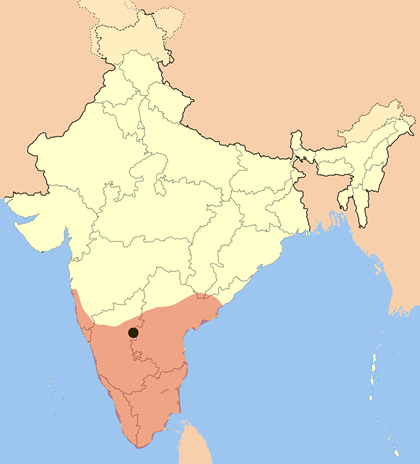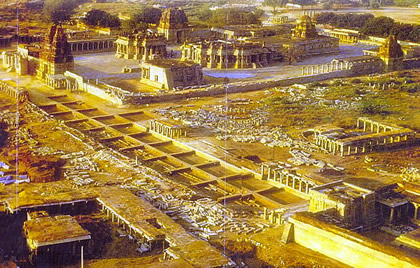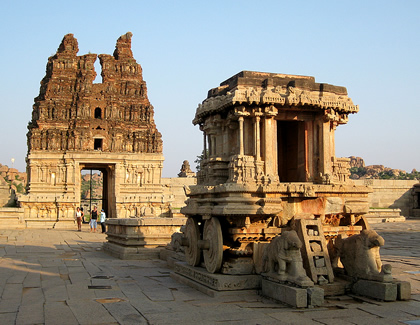World History
The Vijayanagara Empire flourished in southern India from 1336 to 1565. It was a Hindu kingdom that left as its legacy a number of small, independent states that survived until colonial times. The city of Vijayanagara (or Vijayanagar), which means “City of Victory,†is located in modern day Karnataka.
The brothers Harihara and Bukka founded the Vijayanagara state at a time when Muslim rulers were striving to enforce their will and control on Indian people attached to their own religious beliefs and cultural loyalties.
The Deccan Muslim states to the north made various attempts to expand their territories to Vijayanagara to the south. The two brothers were originally Muslims and had served in the administrations of Islamic states.
However when their early military campaigns failed, they changed their religion to Hinduism to achieve greater levels of support from the people they ruled. In 1565 an enemy alliance defeated the Vijayanagaran army and occupied and largely destroyed the city, which has never been fully rebuilt. The state persisted in some of its outlying regions for another century.
The city of Vijayanagara contains elements from various religious traditions. Its earliest deity protectress was Pampa, who was integrated into the Hindu pantheon through her marriage to Virupaksha, a form of Shiva. Other religious elements accumulated over the years.
The cave home of the monkey king of the Ramayana is rumored to exist within the city limits. Jainist and Islamic cultural elements were also introduced through the proximity of believers trading with neighboring states.
The people of southern India were divided into numerous caste and occupation groups, which also depended on where they lived. Consequently it required considerable efforts for rulers to be able to demonstrate legitimacy to rule and also maintain a pluralist polity that would not be too divisive to maintain.
Through the seaports of Calcutta and Basrur, Vijayanagara came into contact with numerous international states and their influences were also represented in southern India and contributed to the quality of life through provision of consumer products and intellectual property.
- Chenla
Chenla army Two successive kingdoms with strong Indian influence emerged during the pre-Angkorean centuries of Khmer history. These were the Funan, from the second to sixth centuries, and Kambuja (Chenla, Zhenla in Chinese) from the sixth to the eighth...
- Tamil Culture
Tamil Culture Tamil is a Dravidian language group that originated in southern India and is not linked to the northern Aryan language group. Tamil speakers are found in Tamilnadu, the region surrounded by Kerela, Karnataka, and Pradesh and parts of present-day...
- Aurangzeb - Emperor Of India
Aurangzeb - Emperor of India Aurangzeb was the sixth Mughal emperor (r. 1658–1707). He ruled for 49 years as Emperor Alamgir (conqueror of the universe); he was the last great ruler of the Mughal dynasty, but left the empire economically exhausted...
- History Of Pakistan
History of Pakistan. This site is a brief essay on the history of the Asian nation of Pakistan. Unfortunately, it is mostly a modern history as it primarily focuses on the 20th Century. Wikipedia notes, "The Islamic Republic of Pakistan (Urdu: ??????...
- History Of Bangladesh
History of Bangladesh. This essay presents the history of Bangladesh in a short and readable format. From the site: Bengal was absorbed into the Mughul Empire in the 16th century, and Dhaka, the seat of a nawab (the representative of the emperor),...
World History
Vijayanagara Empire
 |
| Vijayanagara Map |
The Vijayanagara Empire flourished in southern India from 1336 to 1565. It was a Hindu kingdom that left as its legacy a number of small, independent states that survived until colonial times. The city of Vijayanagara (or Vijayanagar), which means “City of Victory,†is located in modern day Karnataka.
The brothers Harihara and Bukka founded the Vijayanagara state at a time when Muslim rulers were striving to enforce their will and control on Indian people attached to their own religious beliefs and cultural loyalties.
The Deccan Muslim states to the north made various attempts to expand their territories to Vijayanagara to the south. The two brothers were originally Muslims and had served in the administrations of Islamic states.
  |   |
However when their early military campaigns failed, they changed their religion to Hinduism to achieve greater levels of support from the people they ruled. In 1565 an enemy alliance defeated the Vijayanagaran army and occupied and largely destroyed the city, which has never been fully rebuilt. The state persisted in some of its outlying regions for another century.
The city of Vijayanagara contains elements from various religious traditions. Its earliest deity protectress was Pampa, who was integrated into the Hindu pantheon through her marriage to Virupaksha, a form of Shiva. Other religious elements accumulated over the years.
 |
| Vijayanagara ruin |
The cave home of the monkey king of the Ramayana is rumored to exist within the city limits. Jainist and Islamic cultural elements were also introduced through the proximity of believers trading with neighboring states.
The people of southern India were divided into numerous caste and occupation groups, which also depended on where they lived. Consequently it required considerable efforts for rulers to be able to demonstrate legitimacy to rule and also maintain a pluralist polity that would not be too divisive to maintain.
Through the seaports of Calcutta and Basrur, Vijayanagara came into contact with numerous international states and their influences were also represented in southern India and contributed to the quality of life through provision of consumer products and intellectual property.
 |
| Vittala Temple |
- Chenla
Chenla army Two successive kingdoms with strong Indian influence emerged during the pre-Angkorean centuries of Khmer history. These were the Funan, from the second to sixth centuries, and Kambuja (Chenla, Zhenla in Chinese) from the sixth to the eighth...
- Tamil Culture
Tamil Culture Tamil is a Dravidian language group that originated in southern India and is not linked to the northern Aryan language group. Tamil speakers are found in Tamilnadu, the region surrounded by Kerela, Karnataka, and Pradesh and parts of present-day...
- Aurangzeb - Emperor Of India
Aurangzeb - Emperor of India Aurangzeb was the sixth Mughal emperor (r. 1658–1707). He ruled for 49 years as Emperor Alamgir (conqueror of the universe); he was the last great ruler of the Mughal dynasty, but left the empire economically exhausted...
- History Of Pakistan
History of Pakistan. This site is a brief essay on the history of the Asian nation of Pakistan. Unfortunately, it is mostly a modern history as it primarily focuses on the 20th Century. Wikipedia notes, "The Islamic Republic of Pakistan (Urdu: ??????...
- History Of Bangladesh
History of Bangladesh. This essay presents the history of Bangladesh in a short and readable format. From the site: Bengal was absorbed into the Mughul Empire in the 16th century, and Dhaka, the seat of a nawab (the representative of the emperor),...
